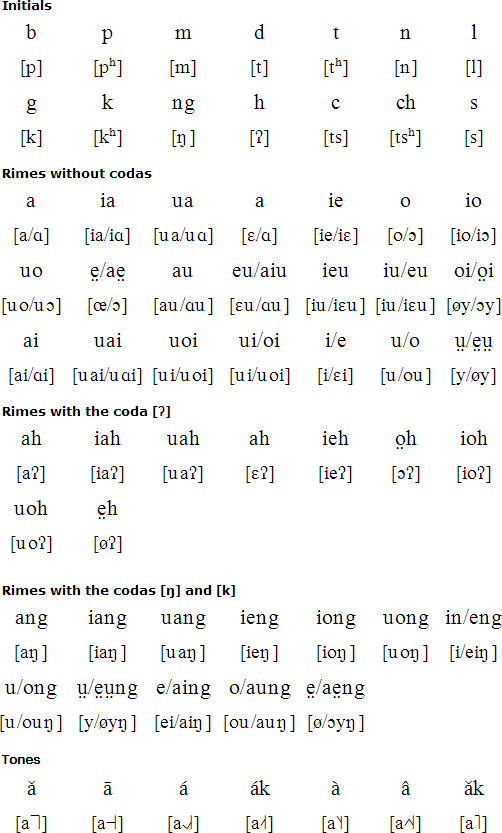Fuzhounese is a variety of Min Dong (Eastern Min), a branch of Min Chinese spoken in eastern parts of Fujian Province in China, and also in Singapore and Malaysia, by about 10 million people. In Fujian the language is known as Bàng-uâ (平話), or "ordinary speech". In Singapore and Malaysia it is known as Hokchiu (福州), which is how Fuzhou is pronounced in Fuzhounese. It is also known as Fuzhou dialect, Foochow, Hoochew, Fuzhounese or Fuzhouhua (福州話).
Fuzhounese is spoken particularly in Fuzhou City (福州市), Pingnan (屏南), Gutian (古田), Luoyuan (羅源), Minqing (閩清), Lianjiang (連江, Matsu included), Minhou (閩侯), Changle (長樂), Yongtai (永泰), Fuqing (福清) and Pingtan (平潭), and is the second local language in other parts of northern and central Fujian.
The first book contain information about the pronunciation of Chinese characters in Fuzhounese was 戚林八音 (Qī Lín Bāyīn / Chék Lìng Báik-ǐng), which was published in the 17th century and provided a standard for the language which is still used by researchers looking at Min Chinese phonology.
During the 19th and early 20th century Western missionaries studied Fuzhounese and produced dictionaries, guides to the language, translation of the Bible. Japanese scholars produced a number of books on the language during the 1940s. The missionaries developed ways of writing Fuzhounese using the Latin alphabet, which were standardised in the 1890s and became known as Foochow Romanized. This system was used mainly in churches and mission schools.
Fuzhounese is spoken by about 50% of young people in Fujian, who until recently were encouraged to abandon it in favour of Mandarin. Such policies have been reversed, however, and Fuzhounese is now officially listed as an Intangible Cultural Heritage and efforts are being made to preserve it and encourage its use. On the island of Matsu, which is controlled by the authorities in Taiwan, Fuzhounese is taught in primary schools.

There is a complex system of tone changes (Sandhi), and many letters are pronounced differently depending on which other letters they appear next to.
Download alphabet charts for Fuzhounese in PDF or Excel format.
Ô sǒ̤h huòi, Báe̤k-hǔng gâe̤ng Nǐk-tàu duǒh hī dó̤i cǎng, káng diê-nè̤ng buōng-sê̤ṳ duâi. Cǎng lì cǎng kó̤ mò̤ suǒ iàng. Ciā sèng-hâiu, duô lā̤ ô sǒ̤h ciéh nè̤ng giàng lā̤, sǐng lā̤ sê̤ṳng duǒh sǒ̤h iông gâu-gâu gì duâi-ǐ. Ǐ lâng ciéh gōng hō̤, diê-nè̤ng ô buōng-sê̤ṳ sěng gáe̤ cī ciéh nè̤ng gâe̤ng duâi-ǐ táung lâi gó̤, cêu sáung diê-nè̤ng buōng-sê̤ṳ duâi.
有蜀回,北風共日頭著許塊爭,看底儂本事大。爭來爭去無輸贏。者辰候,墿嚟有蜀隻儂行嚟,身嚟頌著蜀件厚厚其大衣。伊兩隻講好,底儂有本事先告玆隻儂共大衣褪唻去,就算底儂本事大。
Once upon a time, the North Wind and the Sun were disputing which was stronger. They disputed on and on without reaching a conclusion. Just at that moment, there was a man walking along the road, wearing a very heavy coat. The two agreed that who first succeeded in making this man take his coat off should be considered stronger.
Source: http://en.wikipedia.org/wiki/Foochow_Romanized
Information about Fuzhounese
http://en.wikipedia.org/wiki/Fuzhou_dialect
http://en.wikipedia.org/wiki/Foochow_Romanized
Eastern Min Han character - Latin converter (漢字 - 閩東語羅馬字轉換器)
https://transliterationtools.blogspot.com/2023/11/eastern-min-conversion-tool.html
Dungan, Cantonese, Fuzhounese, Gan, Hakka, Jian'ou, Mandarin, Puxian, Shanghainese, Taiwanese, Taiwanese Hakka, Teochew, Weitou, Wenzhounese, Xiang
Written Chinese: Oracle Bone Script, Simplified characters, Bopomofo, Types of characters, Structure of written Chinese, Evolution of characters, How the Chinese script works, Xiao'erjing, General Chinese
Spoken Chinese: Mandarin, Dungan, Wu, Shanghainese, Wenzhounese, Yue, Cantonese, Weitou, Min, Jian'ou, Taiwanese, Teochew, Fuzhounese, Puxian, Hakka, Xiang, Gan, How many people speak Chinese?
Other Chinese pages: Chinese numbers (數碼) | Chinese classifiers (量詞) | Electronic dictionaries | Chinese links | Books: Chinese characters and calligraphy | Cantonese | Mandarin, Shanghainese, Hokkien and Taiwanese
Akkadian Cuneiform, Ancient Egyptian (Demotic), Ancient Egyptian (Hieratic), Ancient Egyptian (Hieroglyphs), Chinese, Chữ-nôm, Cuneiform, Japanese, Jurchen, Khitan, Linear B, Luwian, Mayan, Naxi, Sawndip (Old Zhuang), Sui, Sumerian Cuneiform, Tangut (Hsihsia)
Page last modified: 02.01.25
[top]
You can support this site by Buying Me A Coffee, and if you like what you see on this page, you can use the buttons below to share it with people you know.

If you like this site and find it useful, you can support it by making a donation via PayPal or Patreon, or by contributing in other ways. Omniglot is how I make my living.
Note: all links on this site to Amazon.com, Amazon.co.uk
and Amazon.fr
are affiliate links. This means I earn a commission if you click on any of them and buy something. So by clicking on these links you can help to support this site.
[top]